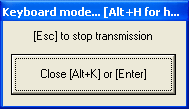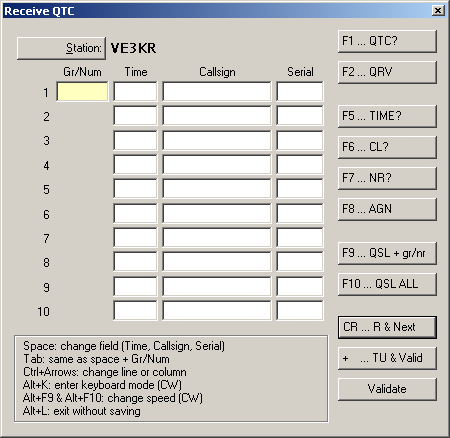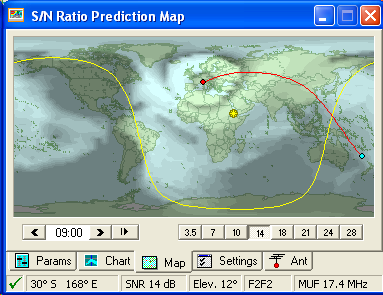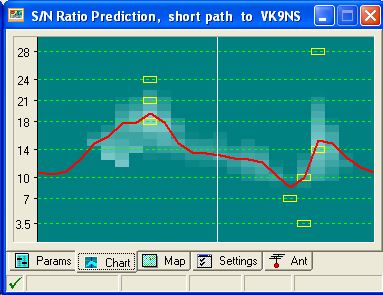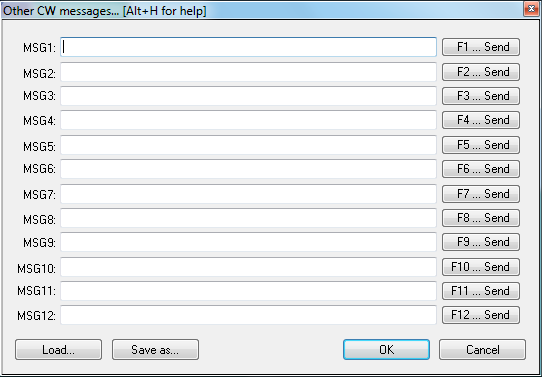Difference between revisions of "Menu:Commands"
| Line 11: | Line 11: | ||
==Keyboard mode== | ==Keyboard mode== | ||
| − | + | Allows you to use the keyboard to generate CW or RTTY text. This is needed in unusual situations, for example to say a few words to your old contesting friend before you send him a report or to manage a DX station to QSY to another band. This feature has no meaning on SSB. | |
| − | Allows to use the keyboard to | ||
[[Image:keyboardmode.png|frame|center|Keyboard Mode]] | [[Image:keyboardmode.png|frame|center|Keyboard Mode]] | ||
| + | |||
| + | You have to type blind - you will only hear (or see in the RTTY monitor) what you have typed when it's being transmitted. | ||
| + | |||
| + | Note that in keyboard mode you have the usual function keys available, so instead of typing your callsign, you may simply press '''<tt>[F5]</tt>'''. | ||
Keyboard mode can also be started with the shortcut '''<tt>Alt-K</tt>'''. | Keyboard mode can also be started with the shortcut '''<tt>Alt-K</tt>'''. | ||
| − | To exit | + | To exit keyboard mode, click on the Stop button, or press ['''<tt>Return</tt>'''] or ['''<tt>Escape</tt>'''] or |
| − | press | + | press again '''<tt>Alt-K</tt>'''. |
| + | |||
| + | By the way, you can stop Keyboard mode when you are done typing - you do not need to wait until the transmission finishes. | ||
==CW Speed...== | ==CW Speed...== | ||
Revision as of 15:16, 1 October 2006
Menu:Commands
QSY
One band down
Modify the band of the current QSO (logging field), to the nearest lower band (vs frequency). While on 160m, the nearest "lower band" will be 10m. Shortcut: Alt-F1. You can also directly type the desired band (if the logging field is empty, of course), and even a frequency in kHz (such as 14265).
One band up
Modify the band of the current QSO (logging field), to the nearest upper band (vs frequency). While on 10m, the nearest "upper band" will be 160m. Shortcut: Alt-F2. You can also directly type the desired band (if the callsign field is empty, of course), and even a frequency in kHz (such as 14265).
Keyboard mode
Allows you to use the keyboard to generate CW or RTTY text. This is needed in unusual situations, for example to say a few words to your old contesting friend before you send him a report or to manage a DX station to QSY to another band. This feature has no meaning on SSB.
You have to type blind - you will only hear (or see in the RTTY monitor) what you have typed when it's being transmitted.
Note that in keyboard mode you have the usual function keys available, so instead of typing your callsign, you may simply press [F5].
Keyboard mode can also be started with the shortcut Alt-K. To exit keyboard mode, click on the Stop button, or press [Return] or [Escape] or press again Alt-K.
By the way, you can stop Keyboard mode when you are done typing - you do not need to wait until the transmission finishes.
CW Speed...
Shortcut: Alt-V. Opens the CW speed dialog box:
In this dialog you also can use :
- Up arrow: Increases the speed by 1 WPM
- Page up: Increases the speed by 2 WPM
- Down arrow: Decreases the speed by 1 WPM
- Page down: Decreases the speed by 2 WPM
The CW-Speed can also changed via Alt-F9 (decreases by 2 WPM) and Alt-F10 (increases by 2 WPM) while operating.
Finally, you can also directly enter a speed (in WPM) in the callsign field and hit Alt-V.
CW Weight...
Open the CW weight dialog box:
This is the weight of dashes to dots - the default value (3.0) should be fine for most people.
Carrier
Sends a carrier to the CW output. You can choose a plain carrier or pulses (in order to take care of the PA while tuning ...). Shortcut Ctrl-T, or enter TUNE in the main window.
To exit this mode, click on the Stop button, press [Return] or [Escape].
Split frequency
Allows to directly adjust the split frequency of the current radio.
A direct access to this dialog box is also possible by typing [Minus] from the numeric keypad, as well as the text command SPLITFREQ in the QSO logging field.
Note that you can enter only the kHz part of the current band.
QSY frequency
Allows you to adjust directly the QSY frequency on the current band.
In the dialog box, you can also use and save the current frequency as a the QSY frequency, by clicking the central button.
You can also have a direct access to this dialog box by using QSYFREQ or PASSFREQ text commands.
This frequency will then appear in the status window.
QSY to run frequency
This command will bring you back to the last frequency on which you hit [F1] (=CQ, your last run frequency). It is accessible with the shortcut Alt-F4.
Swap the frequency on both radios
TODO swap qrg on both radios
Take a sked
Shortcut Alt-E. To take a sked with a station, the following dialog box appears :
You must write down the callsign of the station you want to take a sked with (the current callsign in the logging field will be taken by default), the time of the sked (possibly specifying if this time must shifted + 24h, see comment below), the frequency, the mode (only in a multi mode contest), and an optional comment. Once recorded, the sked will appear in the skeds window.
Remark about the time of the sked : checking the "+ 24 h" box does not always mean that the sked will be taken for "tomorrow", but that the time must be shifted by + 24 hours.
Example 1 : It is Saturday 1000z. You take a sked for Sunday 0600z : do not check the "+ 24 h" box.
Example 2 : It is Saturday 0400z. You take a sked for Sunday 0600z : you must check the "+ 24 h" box, otherwise the sked will be taken for saturday 0600z !
Pass a station
Shortcut Alt-D. To pass a callsign to another operating position (multi operators), the following window appears :
You must write down the callsign of the station you want to pass (default: the callsign in the logging field), the frequency, the mode (only during a multi mode contest), and an optional comment. Once OK is pressed, the infomation will appear in the skeds window.
To make it easier passing a callsign in a multi operating environment, the lower part of window lets you know, by means of filters (combo box), what station is on the band where you wish the calling station to be, and the frequencies of the radios being on that band.
Copy-paste the previous QSO
Shortcut Alt-[UP]. This copies the callsing from previous QSO to the QSO edit field. Useful for passed stations or after QSY.
Receive QTC
Shortcut Alt-L. Only for WAE. Opens the QTC RX dialog box
See WAEDC for more information.
DX-Cluster
Shortcut Alt-T. This window allows you to send commands to the DX cluster you are connected to. These commands are then forwarded either to a TNC physically connected on a COM port, a DX Cluster connection established via the wtDxTelnet application or a remote TNC in a multi computer network.
The buttons of the lower part of the window are pre-defined commands that can be activated by clicking with your mouse.
The count of DX spots and solar data can be set in the Options | DX Cluster Shortcuts menu. This menu also allows you to select which familiy of DX Cluster you are connecting to, either DXNet/AK1A/ARcluster type or the DX Spider type, where command syntax is slightly different.
Since pressing [Escape] would close the current window, you can use ctrl-E to send an Escape character to the TNC (if it is in WA8DED host mode) to generate commands like
* I DL6RAI * S1 * CDB0IGL
All entered commands are stored in a 10-slot recall buffer, in which you can navigate with the [Up] and [Down] arrow keys.
Spot
Shortcut Alt-[F3] Sends, on the DX cluster where you are connected, a spot with the callsign of the current logged QSO. The frequency is the active frequency of the current radio, or the frequency on which the QSO was logged.
You can also modify the command (by adding a comment for example), before sending the spot. To cancel sending a spot, close the dialog box or press escape.
Propagation forecast
Shortcut Ctrl-P.
This function will be activated only if:
- HamCap (by VE3NEA), and its pre-requisite VOACAP, are installed on your computer
and
- a CALLSIGN is typed in the entry field
This is a sample of a Propagation Prediction Map you can get.
Clicking on the Chart Tab this is what will appear:
This is a very comprehensive and useful representation.
The red curve shows the statistical median MUF (50% Maximum Usable Frequency), while the yellow boxes mark the best hour for each ham frequency.
For more information refer to:
Insert into BandMap
Shortcut Ctrl-[Enter]. Inserts - into the band map of the active radio - the callsign captured in the logging field. This is very useful, especially while hunting for multipliers, to quickly detect a station in the band when you turn the VFO knob.
Active Radio
Switches the active radio. A double-click on one of the VFOs of the corresponding Bandmap will provide the same result. The "*" key also swaps the 2 radios (useful for SO2R operation).
Station Type
Indicates the station type for the current QSO. This command is useful for multi operators set-ups (M/S or M/2). At the end of each QSO line, you can see :
- R : RUN
- M : MULTI
- R1 : RUN 1
- R2 : RUN 2
The + indicates if the station is a SUPPORT.
A SUPPORT station has the same settings than the MASTER station it refers to. It allows to have a RUN station, which runs the pile-up, and a RUN SUPPORT station (R+) which seeks for multiplier in the same band as the RUN station (usually called INBAND station). As well, there can also be several MULTI, RUN1 stations ...
CW Messages
Sends the CW messages F1...F7, [Insert] and [+]. See Keys for more information.
You can also open the additional CW messages-dialog (You can even use the shortcut Alt-C for doing this).
You can also modify the additional messages in this dialog.
Remote commands...
Allows you send forward text commands to all other stations connected to the network. For example to restart the log on all stations, use the REOPEN text command in this window.
This menu item only available if more than one station is available on the network.
Use with great care!
